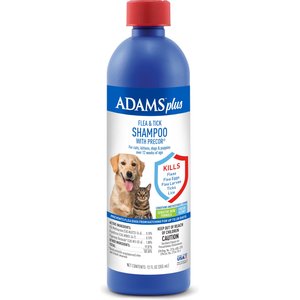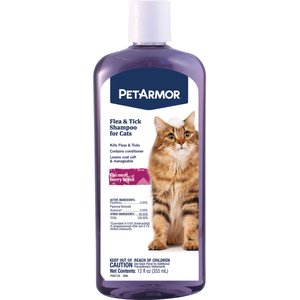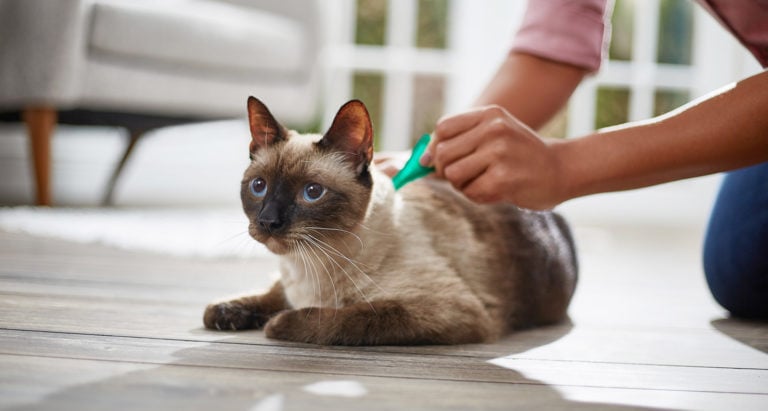Fleas are pests in every sense. They leave us and our pets with itchy skin, and they’re gross and prolific when not dealt with properly. It’s a good thing your cat doesn't have fleas… Or do they? How can you tell whether your cat has fleas? What do flea bites on cats look like?
If you spend time with your cat regularly, you’ll know what’s normal—and what’s not. Many flea-infested cats show both physical and behavioral changes that indicate something is wrong. Here are 10 signs of fleas in cats to help you determine whether your cat has fleas—and how to treat them for fleas if they do have them.
In This Guide
What Do Flea Bites on Cats Look Like?
These can include:
- Pink Bumps: A cat flea bite looks like a single raised, pink bump or clusters of bumps grouped together.
- Rash: When cats are experiencing more intense itching, flea bites can appear like a widespread rash (also known as flea allergy dermatitis).
- Scabs: Due to itchy skin, cats can develop abrasions and skin infections from using their nails to scratch flea bites.
- Hair loss: Your cat may become so stressed by the flea bites that they overgroom, leading to hair loss.
Where Are Flea Bites Usually Found on Cats?
When checking your cat’s skin for flea bites, here’s where you should look for signs of skin irritation first:
- Head and neck
- Base of the tail
- Hind legs
- Back
9 Other Signs of Fleas on Cats
1 Pinhead-Size Black or Reddish-Brown Insects Crawling on Your Cat’s Fur
Probably the most obvious indicator of fleas on your cat is the fleas! Those tiny black or reddish-brown insects on your cat’s fur are the fleas themselves. There’s a good chance you’ll see fleas and flea eggs on your cat or their bedding when you have a heavy infestation.
Part your pet’s fur in several places to see their skin. Fleas gravitate to the neck, lower back, back of hind legs and base of the tail.
2 Intense and Frantic Scratching or Biting from Flea Bites
Flea bites can cause itchiness on a cat’s skin. One of the signs of fleas on cats is sudden scratching of their body with their paws or chewing their skin in an attempt to stop the itchy sensation.
To give them some temporary relief, use cat flea and tick shampoo, such as the following:
3 Excessive Grooming and Hair Loss
Cats are fastidious groomers, but when fleas on cats start biting, their grooming becomes extreme, especially around the back of the hind legs, neck and base of the tail.
Your cat may lick and chew repeatedly, trying to eliminate the itchy sensation. Without intervention, they may groom themselves to the point that you start to see hair loss. You may notice bald patches, especially on the back of the hind legs, neck and around the base of the tail.
4 Avoiding Certain Parts of Your Home
Fleas flourish in warm environments and hide in carpet and furniture. If your cat starts avoiding carpeted areas of your home, consider that a red flag. They’re steering clear of the fleas!
Note that while hard surface flooring is not an ideal environment for fleas, they can still be found in the cracks and crevices of wood and tile flooring.
The first rule of flea control (aside from treating your pet, of course) is to keep a clean house. Thoroughly vacuum your floors and furniture, including under the cushions, on a regular basis. You can also try a natural remedy, like diatomaceous earth, for your carpets and throw rugs.
Wash your cat’s bedding regularly in the washing machine, and spritz your cat’s bedding and furnishings with a pet-safe flea spray for the home.
Consider the following popular flea sprays recommended by cat parents:
5 Agitation, Edginess and Restlessness
Flea irritation can cause your cat to show some serious behavioral changes. Your cat suddenly may behave like a wildcat because the fleas are driving them crazy.
Such behavior might include growling a lot, shaking their head, aggressively rubbing their head and body on the floor, or darting from one end of the room to the other. If this happens, fleas could be the cause.
6 Muscle Loss, Pale Gums and Lethargy
If your cat shows muscle loss, pale gums and lethargy, this could indicate anemia, which is low red blood cell count. This can happen when a huge number of fleas consume a cat’s blood or if the cat is infected by Mycoplasma haemofelis, a blood-borne parasite that is carried by fleas.
Mycoplasma haemofelis is most often seen in kittens, seniors and sick cats.
If your cat shows any of these symptoms, call your vet immediately.
7 Tiny, Pepper-Like Specks on Your Cat’s Fur
Another sign of fleas on cats is “flea dirt.” These dark brown specks are actually flea feces. They’re most often seen on the neck and rump areas, but you may also see some of these specks on your cat’s comb or brush.
If you put some of these granules on a paper towel and mist them with water, they will turn red. That’s because the feces are composed of digested blood.
8 Red Spots in Your Cat’s Bedding Fabric
9 Rice Grains on Your Cat’s Bedding or Around Their Anus
If you see what look like rice grains around your cat’s anus, feces or on their bedding, there is a good chance that your cat has tapeworms.
The “rice grains” are the egg packets that tapeworms release. Tapeworms require fleas as part of their life cycle.
While some cats can develop tapeworms after eating infected prey animals, most cats develop tapeworms from accidentally ingesting an infected flea while grooming themselves.
If you see tapeworms, chances are—unless your cat is a hunter—your cat has fleas.
Don’t Be Fooled!
Even if you don’t see any fleas or flea symptoms in cats, don’t assume there are none in your home. Fleas go through four stages in their life cycle:
- Egg
- Larva
- Pupa
- Adult
Your cat may not have adult fleas on their body, but fleas that are in the egg, larva or pupa stage of development could still be present in your furniture, carpet or baseboards—just days or weeks away from turning into adults and invading your cat.
That’s why it’s important to always be tuned in to the signs of flea infestation, which include spotting fleas on your carpet, hardwood floors, furniture or drapes.
Today, your cat may be flea-free. Tomorrow, they might not be.
Treatment for Flea Bites on Cats
If your concern has been confirmed and your cat has fleas, start flea treatment. This involves treating your cat, your home, your other pets (if you have any) and your yard (if applicable), year-round.
Treatment Options for Your Cat
- Bathe your feline friend with a flea shampoo such as Advantage Flea & Tick Treatment Shampoo for Cats & Kittens.
- If bathing your cat isn’t feasible, use a flea spray. You can try Zodiac Flea & Tick Spray for Dogs, Cats, Puppies & Kittens.
- Thoroughly comb your cat with a flea comb, like the Frisco Double Row Flea Comb. When you’re finished, wash the flea comb with soap and water.
- Finally, use a flea preventative on your cat, like:
- A topical medication such as Frontline Plus Flea and Tick Spot Treatment for Cats
- An oral medication such as PetArmor CapAction Flea Tablets for Cats
- A flea collar such as Seresto Flea & Tick Collar for Cats
For some cats, treatment is necessary for the flea bites themselves. For example:
- Cats with skin allergies may be treated with topical or injectable corticosteroids or Apoquel, an oral allergy medication
- Cats who have developed skin infections may treated with antibiotics (topical, oral or both)
Tips for flea preventatives:
- Unless directed by your vet, do not use more than one type of flea preventative at the same time.
- Check the weight and age guidelines for each product to ensure it’s the correct one for your cat.
If you have other pets, treat them for fleas as well. Watch our Chewtorial on how to treat dogs for fleas.
Treat Your Home
Eliminating the fleas on your cat but leaving your home untreated means you’ll be dealing with fleas for the foreseeable future. Be certain to thoroughly treat the fleas in your house by following our step-by-step guide for home flea treatment.
How to Prevent Flea Bites on Cats
Now that your cat is flea-free, you’ll want to determine how to prevent future flea infestations year-round. Depending on your cat’s lifestyle, your veterinarian can recommend flea prevention with added protection. Some flea products also guard against ticks, heartworm, or intestinal parasites. Remember: Even if your cat spends all day indoors, simple flea prevention may not be sufficient. If you have multiple pets, or yourself have an active lifestyle where you could be exposed to ticks, you especially may also want to consider adding that to your flea prevention routine.
- Oral preventatives: Your cat can take tablets or chewables by mouth to provide flea control and protection against other problems.
- Topical preventatives: Medication applied directly to your cat’s skin can be a simple and easy way to protect your furry friend. Remember not to bathe your pet for several days before or after applying topical medications.
- Flea collars: It’s good to be sure your cat is wearing a collar, which provides extra protection from adult fleas or flea larvae. Ensure your cat’s flea collar fits well and can break away in an emergency.
Interested in specific recommendations? Check out our detailed list of the best flea treatments for cats, compiled by pet parents.
Signs of Fleas in Cats FAQs
Q:
Are fleas in cats visible to the human eye?
Q:
What is the difference between signs of fleas and signs of ticks in cats?
A:Signs of fleas can include itching, scratching, hair loss, scabbed bumps all over the body, flea dirt, and the actual fleas themselves that move fast and jump. Adult fleas have six legs.
A tick usually feels like a small, stationary bump where the tick has attached itself to the cat. A tick has eight legs and moves more slowly, or not at all.
Q:
Where on the cat's body can you spot fleas?
Q:
How long does it take for flea bites on cats to heal?
Q:
How do I prevent flea bites on cats?
About the author: Dr. Sarah Wooten, DVM, is a veterinarian at Sheep Draw Veterinary Hospital in Greeley, Colorado.
Additional reporting by Laura Willard and Lisa Galek.
More about pesky fleas and how to banish them:
Share:

















